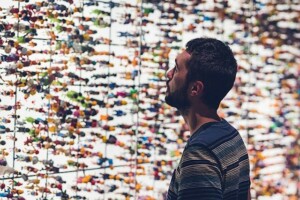“It’s just not good enough for people in our cultural organisations to get away with saying they’re a Luddite, or simply not interested in technology or digital media*, ” says Kati Price, Head of Digital Media at the V&A.
Price joined the museum in October 2013 from her role as Head of Digital at the Design Council.
.jpg) She is clear that if museums and attractions want to significantly increase reach and audience engagement, the benefits of digital media need to be understood and embraced organisation-wide.
She is clear that if museums and attractions want to significantly increase reach and audience engagement, the benefits of digital media need to be understood and embraced organisation-wide.
Blooloop caught up with Price (left) to learn more about her digital ambitions for the world’s leading museum of art and design.
A Dream Job
Price studied for her MA in the History of Design at the Royal College of Art – a course run jointly with the V&A – which, she says, allowed her “behind the scenes of the museum itself and a chance to really research and explore the incredible collections”.
It was another fourteen years before she found herself working there, a job she applied for having seen it advertised “on twitter at 3 in the morning”.
.jpg)
She describes her role as “an amazing opportunity to bring together my experience in creating digital experiences and digital marketing and content and twinning that with a museum and a collection that I really love and means a lot to me – it was the perfect fusion – it is a dream job – I’m very lucky.”
While the term ‘digital’ covers many aspects of the museum’s activities including exhibits and events such as The World of Minecraft, her specific areas are “the digital aspects of our communications and visitor experience”.
.jpg)
Key Objective: Brilliant Content
And, while she admits that the V&A’s biggest goal, as with all museums, is to increase reach, she adds a cautionary note:
“Hitting big numbers is great but engaging with those people is even more important. We’ve got objectives around producing brilliant content that our audiences want and need.”
.jpg)
“We’ve also got an objective around the delivery of that content, ie. the technical side and how we make sure that we can create a flexible digital infrastructure. But, we can also use APIs and other mechanisms to get our content to those people – because they’re not necessarily on our website.
“And then, the third area is around more of an internally focussed objective and that’s brand transformation and obviously, with big digital ambitions, they can’t just be achieved by one small team.
“We need to make sure that everyone in the organisation has digital as part of their job description.”
.jpg)
“We haven’t yet got to that point, but it’s certainly an aspiration, and one we’re working towards whereby people in the organisation understand how digital media can help them do their work and connect more people to their work.”
The Role of Chief Digital Officers
Price has blogged about the role of Chief Digital Officers (CDOs). She believes that understanding the increasing opportunities that digital media has to offer is no longer the preserve of ‘techies’.
.jpg)
“There’s not really one area that digital can’t help or enable in an organisation like a museum or a visitor attraction.”
“We work really closely with colleagues in marketing, visitor experience, communications, on the curatorial side, research… Digital sits in the middle of that spectrum with tech on one side and marketing on the other and we make sure we’re fusing the two.”
Both the quality of content and how that content is delivered are pivotal.
“So, we’re thinking about creating brilliant content, understanding ways to market and getting that content out there and having the right technology underpinning that offer and wrapping it up in an amazing experience that in itself is a brilliant piece of digital design.
“The most obvious destination is our website because a third of all journeys that end up in our building start at our website.
“So, given that it is the first point of a customer journey, it is really important to make that a good one and also one that does feel seamless as it transitions into the building.”
 Mobile Matters
Mobile Matters
Currently, 1 in 3 visitors are engaging with the V&A’s website via mobile and tablet devices.
Is it better to channel content via apps or the website?
“We’re all going through a period where we’re understanding what are the best mechanisms to get content to people, ” acknowledges Price.
“Certainly, mobile is critical for us. Apps have huge potential and can deliver experiences in much more novel ways than can be delivered by a website but, in terms of access, websites also have a role to play.
“We’ve worked on new audio guides for our Europe galleries and we did have a discussion around whether it would be better to serve that content through an app or through the responsive web.
.jpg)
“We decided on the latter for a number of reasons, not least because it keeps the potential audience much larger than if it were an app and it means that anyone with a smartphone can access it instantaneously by typing in a url.”
The museum’s award-winning digital explorer map (above), launched in September 2013, is a good example of an app being the only suitable medium to fill a genuine need.
“It’s a simple solution to a user need that’s a very real one that can’t be delivered through print. It’s a really good example of using digital for things that only digital media can deliver.”
Turning Content into an Experience
One of her ongoing projects is increasing the amount of content from the museum’s collections on the website. Where her digital media team adds value is by coming up with ways to turn that content into an experience:
.jpg)
“We recently launched two online games to coincide with our ‘What is luxury?’ exhibition. One’s called Definery and it asks a series of questions to define whether an object is luxury or vulgar. It’s just a playful exploration of the whole concept of luxury and it’s a way to challenge people’s assumptions and engage in a slightly more playful activity that extends and builds on the sort of themes that the exhibition explores.
“It’s been really interesting to see how we can play with the idea of content – not just packaging up our collections but adding a layer of experience on top of it.”
.jpg)
So, is digital playing a storytelling role around the objects in the collections?
“Absolutely. And, I think there’s so much potential there for us to do more storytelling and add many more layers of content to individual objects so that people can weave their own way through our collections.
“Ultimately, I’d like to get to the point where we can allow people to wend their way through our collections by choosing the narratives that most appeal to them.”
Price cites an app created by the Museum of Old and New Art (MONA) in Tasmania as a good example of this. The museum has done away with labels on the walls altogether.
Instead, visitors use the ‘O’ mobile app (below) which automatically locates the closest artworks and offers information plus enrichment such as the opportunity to listen to the artist talk about that particular piece.

“You choose whichever type of content you want – so you have an object with three different types of information with it and you can choose which one you prefer tonally, ” says Price. [Summary, Ideas, Gonzo or even Art Wank (look closely at the image above)!]
“I think that’s a really neat example of how to personalise experiences, enabling people to make their own choices rather than have this much more didactic type of relationship with an institution.”
Is there a possibility that people would select what they think they should be choosing rather than what they’re actually interested in?
“Well, I guess a lot of the choice is hidden so it’s a bit like people using Kindles to read ’50 Shades of Grey’ – they don’t reveal their choice – it becomes quite anonymous.”
.jpg)
Online Needs and Behaviours
What about her other main goal – increasing traffic to the museum’s website?
Price says that content is one of the key approaches but another ambition is to make the website a destination that “does justice to all our incredible content and collections. At the moment, ours does a good functional job but it could do so much more.
“We’ve done a lot of work around our online audience and segmenting them and understanding their very different needs and behaviours and developing a new brand vision for how the V&A lives and breathes online that betters caters to those different audiences’ needs.”
.jpg)
So, how is she segmenting the museum’s audience?
“It’s absolutely not a demographic breakdown, ” she says, firmly. “It’s around needs and behaviours and particularly around how they currently engage with our website – where they come from, what they do when they get to our website and what they do next.”
Audience Segmentation
“One is visitors – they are people who are likely to end up visiting us physically as well as virtually. We know for 32% of our visitors their journey started with a visit to our website.
“We have around 15 million visitors a year to our website so that translates to around about a 7% conversion. We know roughly how much people spend when they get to the building, so if we up that by 5%, we will actually double our revenue that’s generated by those people whose journey started from the website.”
.jpg)
The second group she describes as enthusiasts: “They’re the fans and they know who we are, they know what they want out of the experience and they just want more opportunities to engage so we’re thinking about how we craft experiences for them.”

The third group are researchers: “These people are not necessarily likely to visit but they’re people who want to explore in more detail our collections and our articles. Their dwell time is high and they have a focussed purpose to their visit, so we’re thinking about ways that we can better cater to that need and also encourage a visit to the building because we know that to explore and experience these objects in the flesh is a wonderful thing.”
.jpg)
The fourth group she calls the inspiration snackers: “They’re the Pinterest crowd, people who will often encounter us through social media maybe through newsletters. They dip in, their engagement is more shallow and then they’ll typically have high bounce rates on the pages they encounter. We know there’s potential to turn them into enthusiasts or visitors.”
Social media, says Price, is a key part of the equation.
“That’s why it’s crucial to work closely with everyone in communications because social media newsletters are increasingly part of the mix.”
The V&A in China
.jpg)
The V&A, like the British Museum, is also looking to expand its reach globally and, to this end, is collaborating with China Merchants Group (CMG) to help them develop a new design museum in China.
The museum has been designed by renowned Japanese architecture studio Maki & Associates and will house a semi-permanent V&A gallery showcasing 20th and 21st century design drawn from the London collections. It is due to open in the Shekou district of Shenzhen in early 2017.
.jpg)
What are the digital challenges around this new project?
“What’s really interesting for us is how we get a deeper understanding of user behaviour in China. It’s so different from here. We need to do a lot more research about the needs of that particular audience – how digital media is used – not just different platforms but different user behaviour.”
.jpg)
Internet of Things
Looking to the future, what are the emerging technologies that excite her?
“I’m really fascinated by the Internet of Things, as is everyone, and where it goes next. It’s still in its caricature phase of talking white goods, but there’s something quite powerful around how a collection could exist on the Internet of Things.
“If we’re all about access and opening up our collections, then it seems like a really obvious move to get our objects up onto the Internet of Things so that other objects could start engaging with ours. How can our objects start engaging with the British Museum’s or non-museum collections?
“It’s a really tantalising, fascinating idea.”
.jpg)
Images kind courtesy V&A apart from:
Ruminant Bloom, Julia Lohmann Studio, 2004. © Julia Lohmann and Venus, after Botticelli, 2008 by Yin Xin. Part of V&A Exhibition ‘Boticelli Reimagined’. Image kind courtesy Guillaume Duhamel/V&A















